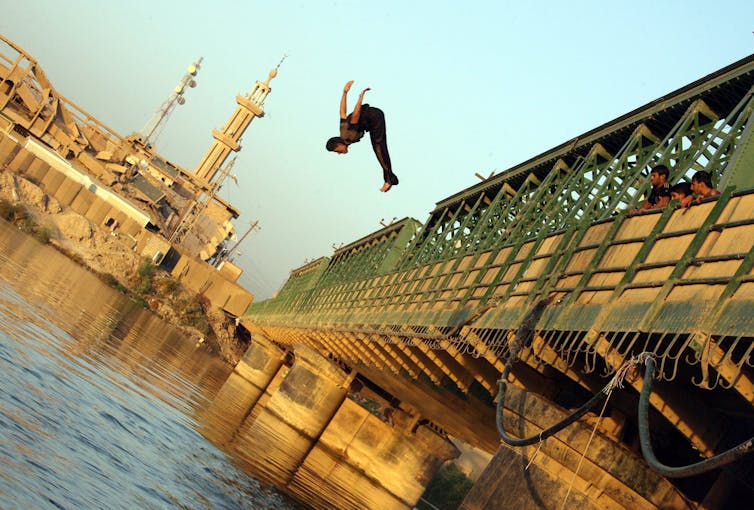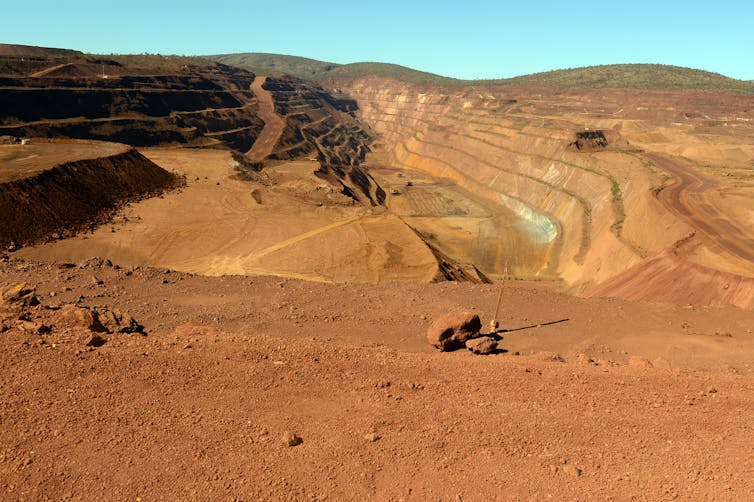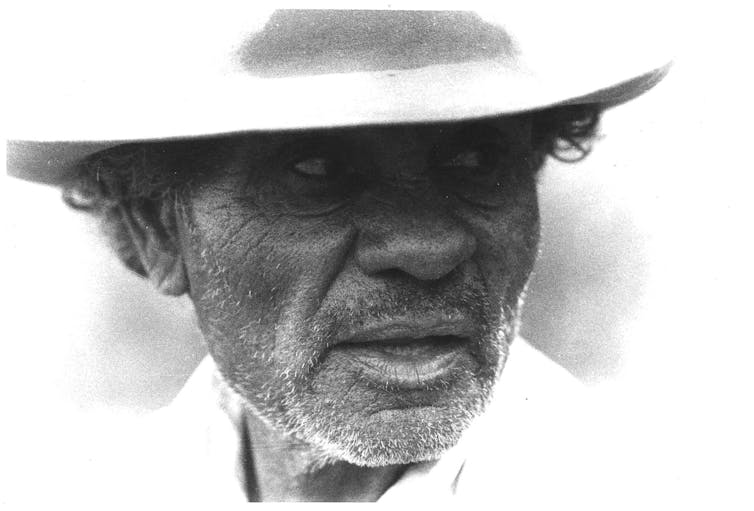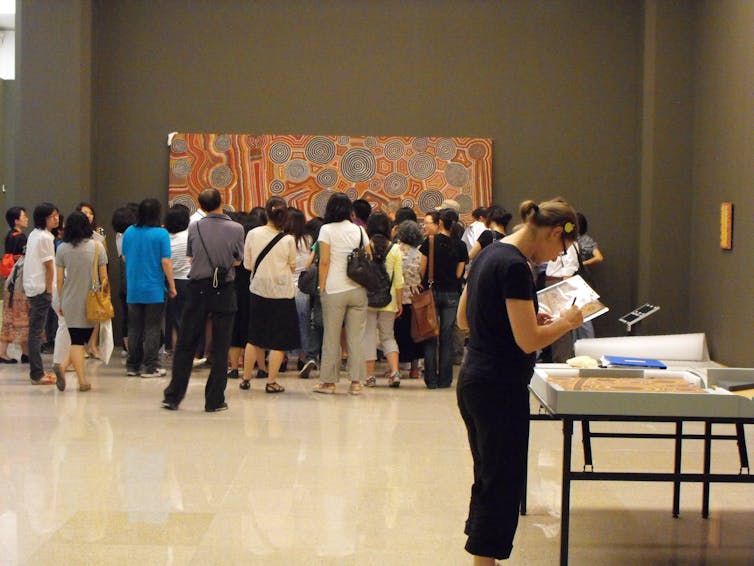rebooting the idea of 'civilisation' for Australian soil
- Written by Stephen Muecke, Chair professor, University of Adelaide
This piece is republished with permission from GriffithReview 63: Writing the Country (Text), ed Ashley Hay.
At the same time as a headline in The Guardian announced: “Indigenous Australians most ancient civilisation on Earth, DNA study confirms”, we could also read that $3 billion had been left by healthcare tycoon Paul Ramsay to set up, under the direction of right-wing former prime ministers John Howard and Tony Abbott, a plan to install courses on “Western civilisation” in major Australian universities.
This contrast is confusing, but telling. Civilisation has nothing to do with science as such (DNA is indifferent to it), nor is it something a passing political initiative can uphold. But with a long view of Australian history, the concept of civilisation is caught precisely in this politically charged dichotomy: between an Indigenous civilisation and a recently arrived “Western” one.
It seems that the upholders of the latter would like the former to remain dubious and “ancient”, of little relevance to the future of the country. This essay is a personal reflection on the possibilities for a more reasonable hybrid definition of “civilisation” based on Australian soil.
What does the word mean? Well, it is city life, if you follow the etymology. From the Latin civis, we derive the group of words that includes “citizen” and “civil”. Outside of the walls of the city roamed the uncivilised, those speaking barbarian tongues. There is a prejudice about civilisation that is reinforced every time the Tigris and Euphrates are cited in accounts of world history as being the “cradle of civilisation”.
 A young man jumps from the old Fallujah bridge into the Euphrates river in Iraq in 2011. There is a prejudice reinforced every time the Euphrates and Tigris are cited in accounts of world history as being the ‘cradle of civilisation’.
Mohammed Jalil/EPA
A young man jumps from the old Fallujah bridge into the Euphrates river in Iraq in 2011. There is a prejudice reinforced every time the Euphrates and Tigris are cited in accounts of world history as being the ‘cradle of civilisation’.
Mohammed Jalil/EPA
Sometimes contesting “cradles” are noted in China, India or the Americas. But rarely mentioned are the oldest continually surviving “cultures”, those of Australia, because it is still hard, in the European tradition, to think of civilisation without cities. But perhaps the idea of building walls to keep others at bay is not such a civilised idea. Let’s consider what civilisation might mean in Australia today, starting with what The Guardian reported as the first civilisations of the country, since they stood the test of a very long period of time – without walls.
Valuing traditional law
I would like to define civilisation as planned, sustainable collective living. The usual definition of it as human society defined by “urban development, social stratification … and a perceived separation from and domination over the natural environment”, as given in Wikipedia, is crying out for revision because it ignores sustainability and relegates non-human life, “nature”, to a resource. Perhaps a new ecological perspective is what is needed as we endeavour to reset modernity, to reboot the idea of living in a civilised fashion within the limits of our earthbound existences.
Far from advocating that Australians today can learn from the wisdom of Indigenous traditions about living “in harmony with nature”, we shall have to rethink the very concept of a singular nature and be aware that it, too, was a colonial imposition on the hundreds of types of country that had in place highly managed, biodiverse ways of living.
So the first step in rebooting civilisation in Australia will be to start with the oldest heritage, in the very places where most Australians can’t see any heritage at all – places they call “remote” simply because they are a long way from cities. The distancing effect of calling them remote contributes to their fragility and degradation at the same time as it generates and invests all major values in the self-assurance of big city life.
But cities, too, are vulnerable, especially in the light of the environmental threats that demand we reset the parameters of civilised life. Tim Flannery, in his 2005 book The Weather Makers, speaks, as many do, about climate change as a threat to civilisation as we know it. He makes it clear he is talking about cities: “Very large cities lie at the heart of our global society, and our most valued institutions are found in them.”
It is a scale-based logic, because those cities under a 100,000 people are not likely to host a university and they need to be over a million to have an opera house. He speaks of the vulnerability to climate change of just this kind of civilisation, because infrastructure designed to deliver water or electricity to millions can be disrupted rapidly, while small towns are more likely to have manageable self-sufficiency.
What he doesn’t mention, as an Australian, are the civilisations that persisted here for many thousands of years. He could have thought of the way the word was used in that context by American anthropologist Lloyd Warner in his 1937 study of the Yolngu, A Black Civilisation. If the Yolngu have flourished for up to 50,000 years, while the kind of civilisation based on large cities could self-destruct after only a few hundred, perhaps it is time to recalibrate what we mean by civilisation.
Today, the Yolngu are among the more robust of Indigenous communities, with their celebrated artistic heritage, their annual Garma Festival, and their business and political skills. A Yolngu kid wanting higher education can head into university in Darwin or another major city, or decide to develop traditional knowledge further by sitting with Elders to eventually “graduate” as a law boss. Or both. Both are viable institutions, so let’s explore their differences for a moment, bearing in mind that one may be more vulnerable to climate change events.
 A clan member of the Yolngu people prepares to perform the Bunggul traditional dance during the Garma Festival near Nhulunbuy, East Arnhem Land, last year.
Mick Tsikas/AAP
A clan member of the Yolngu people prepares to perform the Bunggul traditional dance during the Garma Festival near Nhulunbuy, East Arnhem Land, last year.
Mick Tsikas/AAP
Traditional law and culture is an institution, even if it is not housed in bricks and mortar, and doesn’t need a large annual budget. The Yolngu call it “wangarr”; it is “tjukurpa” in central Australia and “bugarrigarra” in the west Kimberley, where I have worked. People invest time and energy in it, organise each other in different roles and strive for collective outcomes that are highly valued. It includes the process of initiation through which people are literally “made”; in that sense you can’t be a “proper” Aboriginal person without going through the law.
But isn’t it hopelessly idealistic to give value to such traditional institutions, when clearly they can’t be configured in terms of economic progress? Today’s world is one in which everything can be given an economic value, and entities are defined by competition and inequality. Under this regime, traditional knowledge would have to be gathered up by a university or by native title law and turned into accountable knowledge of a more whitefella sort.
For the latter articulation, gaining native title gives communities (sorry, “bodies corporate”) the right to negotiate with mining companies and hence gain royalty or compensation income. That’s just the way things work, you might say. This is the real world, suck it up. And don’t even think about getting a real pay-to-learn university until your community has grown to 100,000.
A monocultural push
Such scaled economisation of the world – reducing everything to the same mechanisms for creating monetary value – is, unfortunately, a monocultural push that tends to destroy the plurality that is civilisation itself. How so? Well, civilisation, as it is defined by those who see it as a collective planning for better ways of living rather than as a dog fight, is one in which numerous religions can have adjacent temples, where scientific knowledge advances, where the law is impartial, the arts flourish and politicians prioritise our collective problems. For the sake of the argument, let’s call the opposite of this a primitive society. Primitives seek to dominate with their narrow agenda.
So if science sought, in the name of its own principles, to slap down the other institutions, debunk religion, dismiss the arts as merely subjective and so on, it would be primitive. People inhabiting a pluralist civilisation will assert the value of difference by saying things like, “Well, we do things this way, but we respect those other folk doing it their way.” You will notice that this is just the kind of wishy-washy relativist talk that the Ayn Rands of the world would denounce as weak liberalism.
For them, only competitive force gains real value; there are only winners and losers, patriots or enemies. Or that’s how they talk. If neoliberal ideology had succeeded in dominating the world, then public bars would be full of poker machines, corporations would be able to buy politicians, art schools would be shut down, the neutrality of the law would be impugned, churches would be profitable, scientific method questioned and Indigenous heritage sites declassified to clear the way for mining. Unthinkable! Thank goodness civilisation in Australia is more robust than that.
Our fragile civilisation
Australia has had some good moments. Once known as the lucky country, it profited from postwar agricultural and industrial development, which morphed into a mining boom until suddenly, very recently, it became stuck between two unsustainable delusions. The country doesn’t know where it came from or where it is going. It still falsely claims that its heritage is white (those more than 50,000-year-old civilisations count for nothing much except tourism revenue), and it is deluded into thinking that it can continue to profit from an ever-expanding global economy.
 The Rio Tinto West Angelas iron ore mine in the Pilbara region of West Australia in 2014.
Alan Porritt/AAP
The Rio Tinto West Angelas iron ore mine in the Pilbara region of West Australia in 2014.
Alan Porritt/AAP
Certainly, this situation has been developing for half a century, but it is the threat of environmental disasters that has suddenly introduced a weird reversal of time. We can’t rely on past form any more. Now it is an actually knowable climate-changed future that is crashing back onto the present with an argument that we must make sensible policy changes. It is this that has opened the fault lines of denial in what I want to call our “fragile civilisation”.
It is like we are stuck on an interminable intercontinental flight and the pilot announces that we will have to land, somewhere, and it is actually a nightmare. We can’t go back to pre-modern life before carbon-fuelled industrial acceleration, and the globe we thought could accommodate everyone’s economic growth is just not big enough to do that. We need to land somewhere else: on Earth perhaps, where we will be bound by Earth’s rules rather than fantasies of endless global expansion; or even escape to another planet.
Two great thinkers have informed me as I composed this essay. It was Bruno Latour, the French philosopher of science, who told me the allegory of the nightmare plane trip with nowhere to land, and who once greeted me when I arrived in Paris with a friendly, “Welcome to civilisation!” His irony was alluding, at the time, to Tony Abbott’s infamous “absolute crap” line on climate science in 2009. The other great influence on me was Paddy Roe, a Goolarabooloo Elder from the west Kimberley who died in 2001.
Roe was born well before World War I and had seen his hometown, Broome, go through the throes of colonisation. Feudal pastoralism and the murderous pearling industry were to give way to resource extraction, but in the middle quiet period of the 20th century, when assimilation policy was the norm, he woke up to the fact that his cherished “bugarrigarra” (law and culture) was dying out. Looking for boys to go through the law, he saw them instead dressed up nicely on their way to church and school, where they learned to look down on the ways of the old people.
 Paddy Roe photographed in 1979.
Photo: Dieter Kirchner
Paddy Roe photographed in 1979.
Photo: Dieter Kirchner
Paddy Roe mobilised some other law bosses and they did what they could to revive positive interest in their heritage. They did this under the name of Goolarabooloo, which is an ancient name for “west coast cultures”. It was never a tribal or language name, but was created long ago to unify a string of communities that follow the songline of the ceremony used every season to sing the boys into men. When the people gather to perform the ritual they draw down on the sacred authority of the “bugarrigarra”, while also drawing in the totemic plants and animals as participants. As custodians, they are conscious that their job is to bring the country to life.
Read more: The case for Gularabulu by Paddy Roe
This Goolarabooloo society is thus more expansive than small tribal or language groupings. One could call it a cultural confederacy, a bit like the European Union. That concept was invented, after seeing the horrors that paranoid nationalism produced, to consolidate peace after the great European wars.
Perhaps it was with the same motive of keeping the peace that the Goolarabooloo ancestors came up with this unifying structure that made people come together to vitalise the country they loved with the gift of new young life: boys who would gain important knowledge as they turned into men.
Without this expansive and inclusive philosophy, internecine warfare may have been more common. Life would indeed have been less civilised.
Indigenous foundations
As the oversize aircraft of late modernity circles, looking for a place to land, Indigenous Australian civilisations are still there in their places. They have always known the overriding importance of caring for their own territories. They are willing to negotiate once again, and this time the stakes are on a planetary scale. But more locally, how can we reconcile Australia’s Indigenous heritage – our civilisational foundation, as I have argued – with the economic story that has brought huge benefits, but is now hitting a wall?
If we reinstall confidence in our public institutions, granting them their own dignity and autonomous power and not making them compete quite so much, then we will have perpetuated the plurality of ways of being in the world that many see as the basis for civilised life. These institutions reform themselves as a matter of course. Today they need more urgent reform to be adequate for the future crises of the Anthropocene, and each can incorporate the knowledge of the first civilisations in very useful ways.
It is the essence of scientific knowledge to be testable and reliable over time, but there is more than one way of assuring this. Steve Salisbury, a palaeontologist from the University of Queensland, can produce a rebooted palaeontology that treats Indigenous people as colleagues and values mythological accounts of dinosaurs as knowledge that complements the discipline, not as mere belief. In the aesthetic field, we have already seen the revolution in painting that was the movement originating in Papunya.
 People examine a painting in the exhibition, Papunya Painting: Out of the Australian Desert at the National Art Museum of China in 2010.
Karen Fielding/National Museum of Australia
People examine a painting in the exhibition, Papunya Painting: Out of the Australian Desert at the National Art Museum of China in 2010.
Karen Fielding/National Museum of Australia
Art critic Robert Hughes called it the last great art movement of the 20th century, and it continues to inspire other art forms. It also created a valuable industry, spinning off into other economic benefits. Each major institution can thus be reset with the Indigenous foundations in place. Mabo was such a moment for Australian law.
Read more: Friday essay: how the Men's Painting Room at Papunya transformed Australian art
In this way, the somewhat difficult concept of civilisation can be recuperated, not by rising to the defence of unlimited scientific and economic progress, nor by taking Enlightenment values as given, but by specifying how the institutions that negotiate such values can be reformed. I clearly don’t mean “reform” in the euphemistic sense used by conservatives bent on actually dismantling these institutions or selling them off. They are happy to see one set – economic institutions – as “naturally” dominating all the others.
One must be careful not to let the concept of “civilisation” be too easily returned to cultural or racial categories (as in “Islamic” or “Jewish” civilisation) that lead to Samuel Huntington-like clashes. Instead, the focus here is more usefully on the collective value of public institutions as defenders of civil behaviour and common resources, including the resources usually called “natural”.
Paddy Roe had a beautiful way of expressing the sovereignty of his Goolarabooloo country. He invited everyone in. He was delighted to teach people, show them places and sing the songs. He set up one of the first Indigenous heritage trails, the Lurujarri Trail, which his descendants have run for 30 years. It has invited hundreds of people to walk a songline along the beach north of Broome. As they walk they get a feeling for country (the local word for this is “liyan”) that may even be transformative for them, a bit like the curiously named “naturalisation” ceremonies that initiate the new citizens of a nation.
It is a curious name because the usual ceremony is simply about giving a person a new legal status. But I’d like to appropriate the term to drive home my conclusion. Naturalisation is not about getting closer to the nature of a country. No one is “close to nature”. No, not Indigenous people, even if wilderness advocates like to think so. We are all negotiating our way through the inevitable entanglements of nature and culture.
So to avoid the pitfalls of a notion of civilisation as forever transcending and dominating nature, with the pious hope of leaving barbarous instincts behind, we might have to take the ecological step of imagining future Australian citizens being “re-naturalised” in particular “countries”, a process in which the natural and the civilised are no longer in opposition. The controls of the modernist airliner have now been recalibrated. In order to land we shall have to be refitted, realistically, to the scale of what each territory is capable of sustaining.
With the Anthropocene, says Bruno Latour, we have made the “rather distressing discovery that humans have become a geological force”, one that is capable of destroying our planetary home. But he goes on to say it could become “an index of an entirely different composition: that of a possible civilisation”. This is a new kind of civilisation that he calls “earthbound”, meaning both tied to territory and heading towards it.
As Australia continues its work-in-progress that I have attempted to call our “hybrid civilisation”, we can weave into its composition the knowledge of country, and the love of country, that makes us all its privileged custodians.
Authors: Stephen Muecke, Chair professor, University of Adelaide




